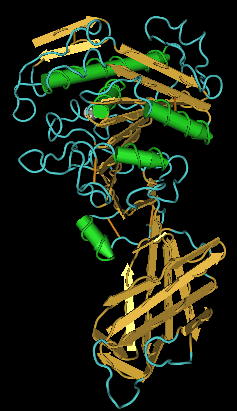Lipase

Lipase is an enzyme that catalyzes the hydrolysis of lipids. Lipases are a subclass of the esterases.
Function[edit]
Lipases perform essential roles in the digestion, transport, and processing of dietary lipids (e.g., triglycerides, fats, oils) in most, if not all, living organisms. Genes encoding lipases are even present in certain viruses. Most lipases act at a specific position on the glycerol backbone of a lipid substrate (A1, A2 or A3) (small intestine). For example, human pancreatic lipase (HPL), which is the main enzyme that breaks down dietary fats in the human digestive system, converts triglyceride substrates found in ingested oils to monoglycerides and two fatty acids.
Types of Lipases[edit]
There are several types of lipases, including:
- Pancreatic lipase: Secreted by the pancreas, it is the primary enzyme responsible for breaking down dietary fats in the human digestive system.
- Hepatic lipase: Found in the liver, it plays a role in the metabolism of lipoproteins.
- Lipoprotein lipase: Located on the walls of blood vessels, it breaks down triglycerides in lipoproteins into free fatty acids and glycerol.
- Gastric lipase: Secreted by the stomach, it is involved in the digestion of dietary fats.
Mechanism of Action[edit]
Lipases catalyze the hydrolysis of ester bonds in lipids, resulting in the formation of glycerol and free fatty acids. The enzyme binds to the lipid substrate and, through a series of chemical reactions, breaks the ester bonds. This process is essential for the absorption of dietary fats in the small intestine.
Clinical Significance[edit]
Abnormal levels of lipase in the blood can indicate various medical conditions. Elevated lipase levels are often associated with pancreatitis, an inflammation of the pancreas. Low levels of lipase may indicate chronic pancreatic insufficiency or other conditions affecting the pancreas.
Industrial Applications[edit]
Lipases are used in various industrial applications, including:
- Detergents: Lipases are added to laundry detergents to help break down fat stains.
- Food industry: Used in the processing of dairy products, baking, and the production of flavors.
- Biotechnology: Employed in the synthesis of biodiesel and other biochemicals.
See Also[edit]
References[edit]
<references group="" responsive="1"></references>
External Links[edit]
Ad. Transform your life with W8MD's Budget GLP-1 injections from $75


W8MD offers a medical weight loss program to lose weight in Philadelphia. Our physician-supervised medical weight loss provides:
- Weight loss injections in NYC (generic and brand names):
- Zepbound / Mounjaro, Wegovy / Ozempic, Saxenda
- Most insurances accepted or discounted self-pay rates. We will obtain insurance prior authorizations if needed.
- Generic GLP1 weight loss injections from $75 for the starting dose.
- Also offer prescription weight loss medications including Phentermine, Qsymia, Diethylpropion, Contrave etc.
NYC weight loss doctor appointmentsNYC weight loss doctor appointments
Start your NYC weight loss journey today at our NYC medical weight loss and Philadelphia medical weight loss clinics.
- Call 718-946-5500 to lose weight in NYC or for medical weight loss in Philadelphia 215-676-2334.
- Tags:NYC medical weight loss, Philadelphia lose weight Zepbound NYC, Budget GLP1 weight loss injections, Wegovy Philadelphia, Wegovy NYC, Philadelphia medical weight loss, Brookly weight loss and Wegovy NYC
|
WikiMD's Wellness Encyclopedia |
| Let Food Be Thy Medicine Medicine Thy Food - Hippocrates |
Medical Disclaimer: WikiMD is not a substitute for professional medical advice. The information on WikiMD is provided as an information resource only, may be incorrect, outdated or misleading, and is not to be used or relied on for any diagnostic or treatment purposes. Please consult your health care provider before making any healthcare decisions or for guidance about a specific medical condition. WikiMD expressly disclaims responsibility, and shall have no liability, for any damages, loss, injury, or liability whatsoever suffered as a result of your reliance on the information contained in this site. By visiting this site you agree to the foregoing terms and conditions, which may from time to time be changed or supplemented by WikiMD. If you do not agree to the foregoing terms and conditions, you should not enter or use this site. See full disclaimer.
Credits:Most images are courtesy of Wikimedia commons, and templates, categories Wikipedia, licensed under CC BY SA or similar.
Translate this page: - East Asian
中文,
日本,
한국어,
South Asian
हिन्दी,
தமிழ்,
తెలుగు,
Urdu,
ಕನ್ನಡ,
Southeast Asian
Indonesian,
Vietnamese,
Thai,
မြန်မာဘာသာ,
বাংলা
European
español,
Deutsch,
français,
Greek,
português do Brasil,
polski,
română,
русский,
Nederlands,
norsk,
svenska,
suomi,
Italian
Middle Eastern & African
عربى,
Turkish,
Persian,
Hebrew,
Afrikaans,
isiZulu,
Kiswahili,
Other
Bulgarian,
Hungarian,
Czech,
Swedish,
മലയാളം,
मराठी,
ਪੰਜਾਬੀ,
ગુજરાતી,
Portuguese,
Ukrainian
